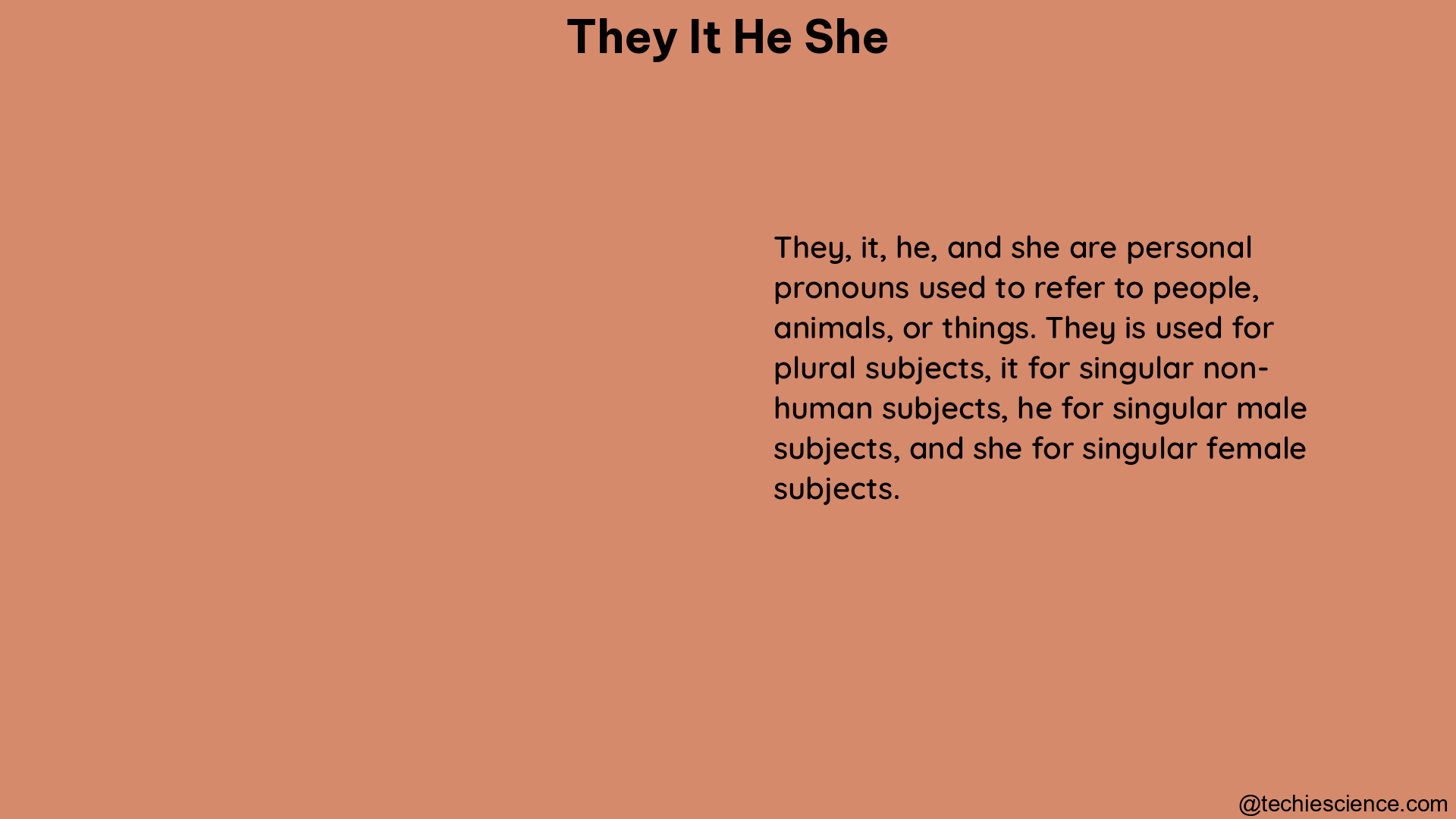The subject pronouns “they,” “it,” “he,” and “she” are essential elements of English grammar, used to replace nouns and refer to people, animals, places, and things. This comprehensive guide will delve into the nuances of these pronouns, providing detailed explanations, advanced usage, and practical examples to help you master their application.
Understanding Subject Pronouns
Subject pronouns are personal pronouns that serve as the subject of a verb. They are used to replace nouns and provide a concise way to refer to different entities in a sentence. The main subject pronouns in English are:
- I (first person singular)
- We (first person plural)
- You (second person singular and plural)
- He (third person singular masculine)
- She (third person singular feminine)
- They (third person singular and plural)
- It (third person singular)
Each of these pronouns has specific uses and applications, which we will explore in detail.
Singular and Plural Pronouns

The subject pronouns can be divided into singular and plural forms:
| Singular | Plural |
|---|---|
| I | We |
| You | You |
| He | They |
| She | They |
| It | They |
The singular pronouns (“I,” “you,” “he,” “she,” “it”) refer to a single person, animal, or thing, while the plural pronouns (“we,” “you,” “they”) refer to a group of people, animals, or things.
Using “They” for Unknown Gender or Non-Binary Individuals
In recent years, the use of “they” as a singular pronoun has gained widespread acceptance, particularly when referring to individuals whose gender identity is unknown or non-binary. This usage of “they” is an inclusive and respectful way to address people without making assumptions about their gender.
Example:
– “Someone left their phone. They must be worried.”
Referring to Specific Genders with “He” and “She”
The pronouns “he” and “she” are used to refer to individuals with specific gender identities. “He” is used for males, while “she” is used for females.
Examples:
– “John is going to the store. He will buy milk.”
– “Mary is going to the store. She will buy eggs.”
Using “It” for Objects and Animals
The pronoun “it” is used to refer to objects, animals of unknown gender, or things. It is a neutral pronoun that does not convey any gender information.
Example:
– “The cat is sleeping. It is very cute.”
Plural Usage of “They”
In addition to its use for unknown or non-binary individuals, “they” can also be used to refer to a group of people, animals, or things.
Example:
– “The students are studying for their exam. They need to focus.”
Advanced Considerations
-
Antecedent Agreement: The subject pronoun must agree with the noun it is replacing (the antecedent) in number (singular or plural) and gender (masculine, feminine, or neutral).
-
Possessive Pronouns: Subject pronouns have corresponding possessive pronouns, such as “my,” “our,” “your,” “his,” “her,” “their,” and “its,” which are used to indicate ownership or possession.
-
Reflexive Pronouns: Subject pronouns also have corresponding reflexive pronouns, such as “myself,” “ourselves,” “yourself,” “himself,” “herself,” “themselves,” and “itself,” which are used to indicate that the subject is performing an action on itself.
-
Indefinite Pronouns: Pronouns like “someone,” “anyone,” and “everyone” are considered indefinite pronouns and can be used with “they” to refer to an unspecified individual.
-
Formal and Informal Usage: In formal writing, the use of “he” or “she” is often preferred over the use of “they” when referring to a single individual of unknown gender. However, in informal and inclusive contexts, the use of “they” is becoming more widely accepted.
By understanding the nuances of subject pronouns, you can effectively and accurately use “they,” “it,” “he,” and “she” in your written and spoken English communication.
Reference:
- https://www.esolcourses.com/uk-english/pre-intermediate-grammar/personal-pronouns/subject-pronouns.html
- https://www.reddit.com/r/grammar/comments/15z3kuu/they_instead_of_heshe/
- https://www.npr.org/2021/06/02/996319297/gender-identity-pronouns-expression-guide-lgbtq

The lambdageeks.com Core SME Team is a group of experienced subject matter experts from diverse scientific and technical fields including Physics, Chemistry, Technology,Electronics & Electrical Engineering, Automotive, Mechanical Engineering. Our team collaborates to create high-quality, well-researched articles on a wide range of science and technology topics for the lambdageeks.com website.
All Our Senior SME are having more than 7 Years of experience in the respective fields . They are either Working Industry Professionals or assocaited With different Universities. Refer Our Authors Page to get to know About our Core SMEs.